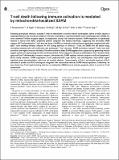T-cell death following immune activation is mediated by mitochondria-localized SARM
Author(s)
Panneerselvam, P.; Singh, L. P.; Selvarajan, V.; Chng, W. J.; Ng, S. B.; Tan, N. S.; Ho, B.; Ding, Jeak Ling; Chen, Jianzhu; ... Show more Show less
DownloadChen_T-cell death.pdf (3.868Mb)
PUBLISHER_CC
Publisher with Creative Commons License
Creative Commons Attribution
Terms of use
Metadata
Show full item recordAbstract
Following acute-phase infection, activated T cells are terminated to achieve immune homeostasis, failure of which results in lymphoproliferative and autoimmune diseases. We report that sterile α- and heat armadillo-motif-containing protein (SARM), the most conserved Toll-like receptors adaptor, is proapoptotic during T-cell immune response. SARM expression is significantly reduced in natural killer (NK)/T lymphoma patients compared with healthy individuals, suggesting that decreased SARM supports NK/T-cell proliferation. T cells knocked down of SARM survived and proliferated more significantly compared with wild-type T cells following influenza infection in vivo. During activation of cytotoxic T cells, the SARM level fell before rising, correlating inversely with cell proliferation and subsequent T-cell clearance. SARM knockdown rescued T cells from both activation- and neglect-induced cell deaths. The mitochondria-localized SARM triggers intrinsic apoptosis by generating reactive oxygen species and depolarizing the mitochondrial potential. The proapoptotic function is attributable to the C-terminal sterile alpha motif and Toll/interleukin-1 receptor domains. Mechanistically, SARM mediates intrinsic apoptosis via B cell lymphoma-2 (Bcl-2) family members. SARM suppresses B cell lymphoma-extra large (Bcl-xL) and downregulates extracellular signal-regulated kinase phosphorylation, which are cell survival effectors. Overexpression of Bcl-xL and double knockout of Bcl-2 associated X protein and Bcl-2 homologous antagonist killer substantially reduced SARM-induced apoptosis. Collectively, we have shown how T-cell death following infection is mediated by SARM-induced intrinsic apoptosis, which is crucial for T-cell homeostasis.
Date issued
2012-11Department
Massachusetts Institute of Technology. Department of Biology; Koch Institute for Integrative Cancer Research at MITJournal
Cell Death and Differentiation
Publisher
Nature Publishing Group
Citation
Panneerselvam, P, L P Singh, V Selvarajan, W J Chng, S B Ng, N S Tan, B Ho, J Chen, and J L Ding. “T-cell death following immune activation is mediated by mitochondria-localized SARM.” Cell Death and Differentiation 20, no. 3 (November 23, 2012): 478-489. © 2014 ADMC Associazione Differenziamento e Morte Cellulare
Version: Final published version
ISSN
1350-9047
1476-5403